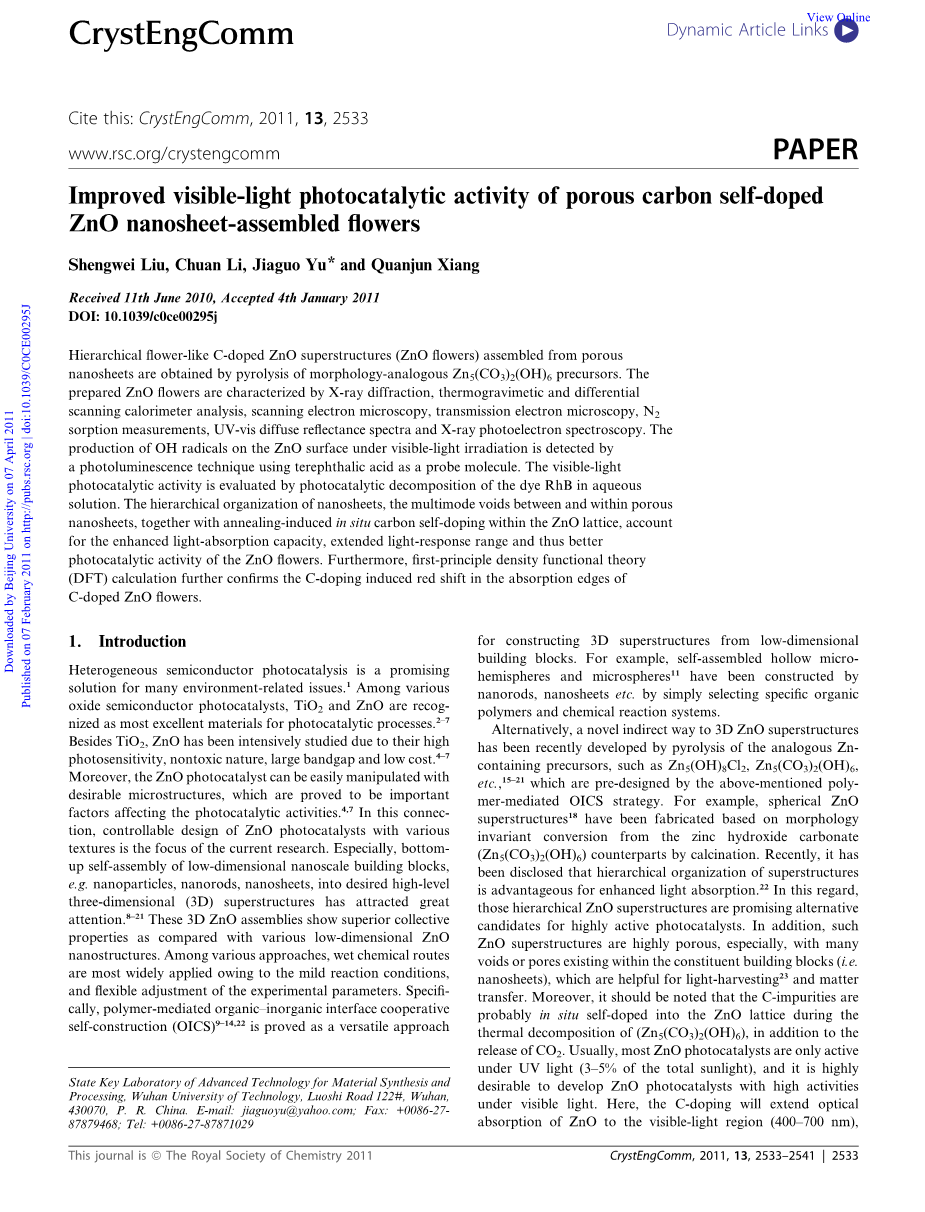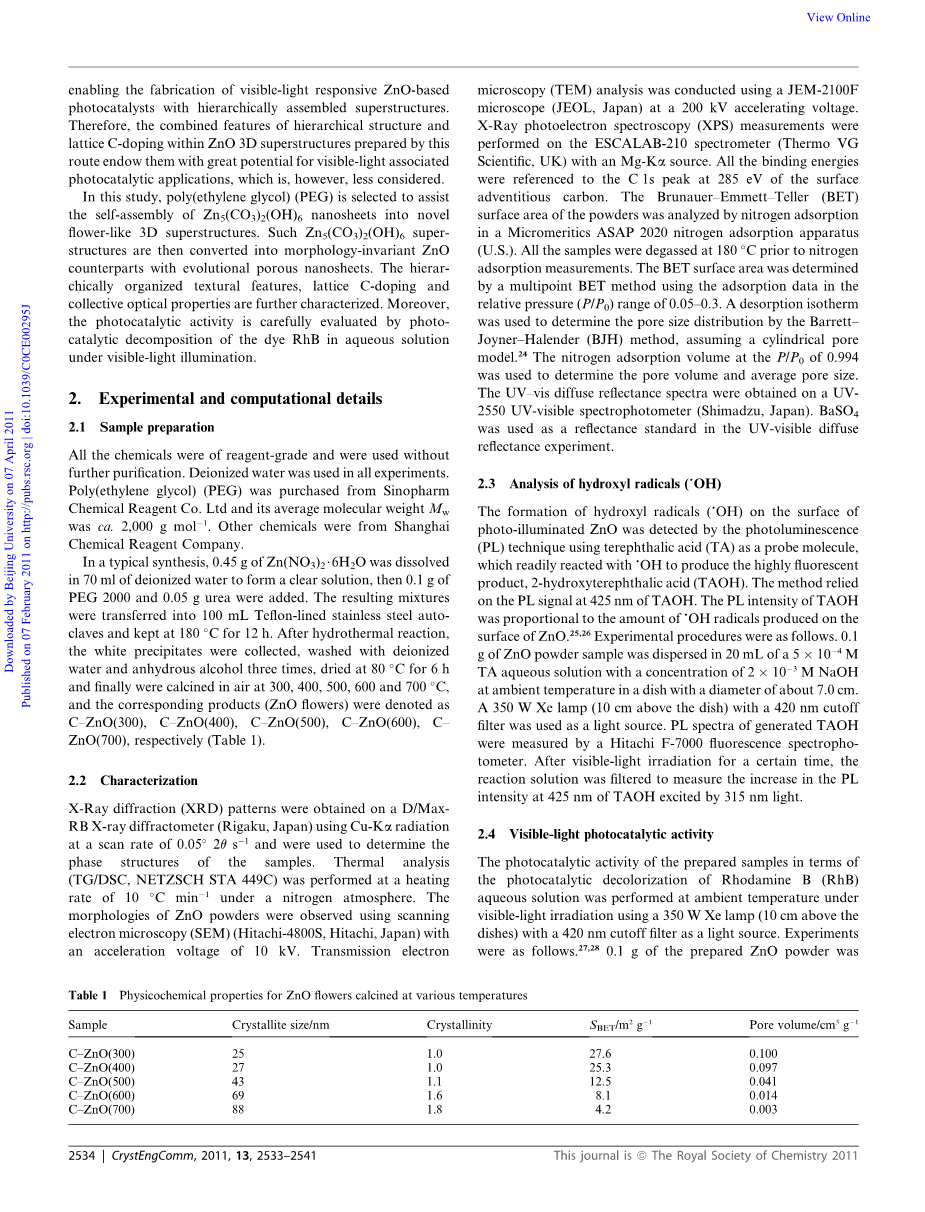

英语原文共 9 页,剩余内容已隐藏,支付完成后下载完整资料
Improved visible-light photocatalytic activity of porous carbon self-doped
ZnO nanosheet-assembled flowers
Shengwei Liu, Chuan Li, Jiaguo Yu and Quanjun Xiang
Received 11th June 2010, Accepted 4th January 2011
DOI: 10.1039/c0ce00295j
Hierarchical flower-like C-doped ZnO superstructures (ZnO flowers) assembled from porousnanosheets are obtained by pyrolysis of morphology-analogous Zn5 (CO3)2(OH)6 precursors. The prepared ZnO flowers are characterized by X-ray diffraction, thermogravimetic and differential scanning calorimeter analysis, scanning electron microscopy, transmission electron microscopy, N2 sorption measurements, UV-vis diffuse reflectance spectra and X-ray photoelectron spectroscopy. Theproduction of OH radicals on the ZnO surface under visible-light irradiation is detected by a photoluminescence technique using terephthalic acid as a probe molecule. The visible-light photocatalytic activity is evaluated by photocatalytic decomposition of the dye RhB in aqueous solution. The hierarchical organization of nanosheets, the multimode voids between and within porous
nanosheets, together with annealing-induced in situ carbon self-doping within the ZnO lattice, account for the enhanced light-absorption capacity, extended light-response range and thus better photocatalytic activity of the ZnO flowers. Furthermore, first-principle density functional theory (DFT) calculation further confirms the C-doping induced red shift in the absorption edges of C-doped ZnO flowers.
Heterogeneous semiconductor photocatalysis is a promising solution for many environment-related issues. Among various oxide semiconductor photocatalysts, TiO2 and ZnO are recognized as most excellent materials for photocatalytic processes. Besides TiO2 , ZnO has been intensively studied due to their high photosensitivity, nontoxic nature, large bandgap and low cost. Moreover, the ZnO photocatalyst can be easily manipulated with
desirable microstructures, which are proved to be important factors affecting the photocatalytic activities.In this connection, controllable design of ZnO photocatalysts with various textures is the focus of the current research. Especially, bottom-up self-assembly of low-dimensional nanoscale building blocks,e.g. nanoparticles, nanorods, nanosheets, into desired high-levelthree-dimensional (3D) superstructures has attracted great attention. These 3D ZnO assemblies show superior collective properties as compared with various low-dimensional ZnO nanostructures. Among various approaches, wet chemical routes are most widely applied owing to the mild reaction conditions,and flexible adjustment of the experimental parameters. Specifically, polymer-mediated organic–inorganic interface cooperative self-construction (OICS) is proved as a versatile approach for constructing 3D superstructures from low-dimensional building blocks. For example, self-assembled hollow micro-hemispheres and microspheres have been constructed by nanorods, nanosheets etc. by simply selecting specific organic polymers and chemical reaction systems.
Alternatively, a novel indirect way to 3D ZnO superstructures has been recently developed by pyrolysis of the analogous Zn-containing precursors, such as Zn 5 (OH) 8 Cl 2 , Zn 5(CO3)2 (OH) 6 ,etc., which are pre-designed by the above-mentioned polymer-mediated OICS strategy. For example, spherical ZnO superstructures have been fabricated based on morphology invariant conversion from the zinc hydroxide carbonate (Zn 5 (CO3 ) 2 (OH)6 ) counterparts by calcination. Recently, it has been disclosed that hierarchical organization of superstructures is advantageous for enhanced light absorption.In this regard,those hierarchical ZnO superstructures are promising alternative candidates for highly active photocatalysts. In addition, such ZnO superstructures are highly porous, especially, with many voids or pores existing within the constituent building blocks (i.e.nanosheets), which are helpful for light-harvesting and matter transfer. Moreover, it should be noted that the C-impurities are probably in situ self-doped into the ZnO lattice during the thermal decomposition of (Zn 5 (CO3 ) 2 (OH)6 ), in addition to the release of CO2. Usually, most ZnO photocatalysts are only active under UV light (3–5% of the total sunlight), and it is highly desirable to develop ZnO photocatalysts with high activities under visible light. Here, the C-doping will extend optical absorption of ZnO to the visible-light region (400–700 nm), enabling the fabrication of visible-light responsive ZnO-based photocatalysts with hierarchically assembled superstructures.Therefore, the combined features of hierarchical structure and lattice C-doping within ZnO 3D superstructures prepared by this route endow them with great potential for visible-light associated photocatalytic applications, which is, however, less considered.In this study, poly(ethylene glycol) (PEG) is selected to assist the self-assembly of(Zn 5 (CO3 ) 2 (OH)6 )nanosheets into novel flower-like 3D superstructures. Such (Zn 5 (CO3 ) 2 (OH)6 )super-structures are then converted into morphology-invariant ZnO
counterparts with evolutional porous nanosheets. The hierar-chically organized textural features, lattice C-doping and collective optical properties are further characterized. Moreover,the photocatalytic activity is carefully evaluated by photo-catalytic decomposition of the dye RhB in aqueous solution under visible-light illumination.
2. Experimental and computational details
2.1 Sample preparation
All the chemicals were of reagent-grade and were used without furth
剩余内容已隐藏,支付完成后下载完整资料
资料编号:[608018],资料为PDF文档或Word文档,PDF文档可免费转换为Word
课题毕业论文、文献综述、任务书、外文翻译、程序设计、图纸设计等资料可联系客服协助查找。
您可能感兴趣的文章
- 基于兰道理论方法的解释1,6-己二酸单斜晶型晶体的一阶温度相关相变外文翻译资料
- 蓝移紫外吸收和高CO转化率活性的非模板水热法衍生介孔Ceo.2Zro.802纳米粉体外文翻译资料
- 提高多孔碳自掺杂ZnO纳米片组装花的可见光催化活性外文翻译资料
- 磷化氢功能化Fe3O4纳米粒子负载钯作为水介质中Suzuki-Miyaura 偶联反应的新型磁分离催化剂外文翻译资料
- 木质素磺酸:一种有效的可再生的以生物高分子为基础的多组分反应催化剂的研究进展外文翻译资料
- 白藜芦醇在体外诱导人膀胱癌细胞凋亡和细胞周期阻滞在体内抑制肿瘤生长外文翻译资料
- 全长人类ACE2识别SARS-CoV-2的结构基础外文翻译资料
- 双吲哚衍生物的抗肿瘤活性外文翻译资料
- 蛋白质分子:将蛋白质靶向到Skp1-Cullin-Fbox复合物上进行泛素化和降解的嵌合分子外文翻译资料
- 用钼酸铋催化剂将丙烯醛氨氧化成丙烯腈外文翻译资料


